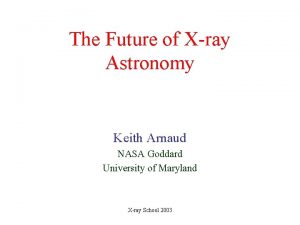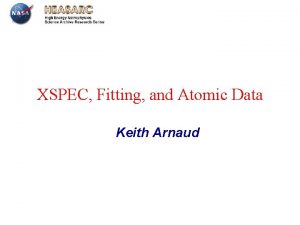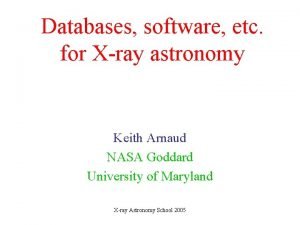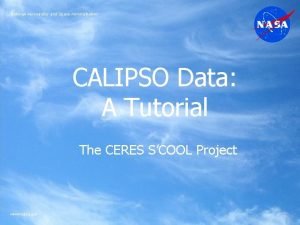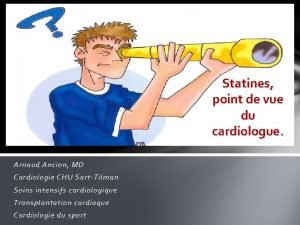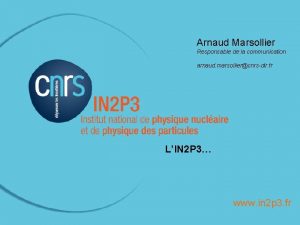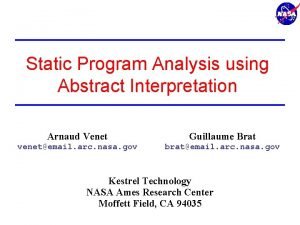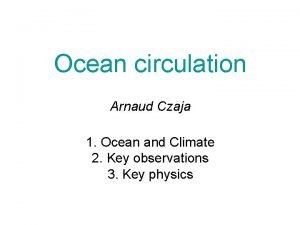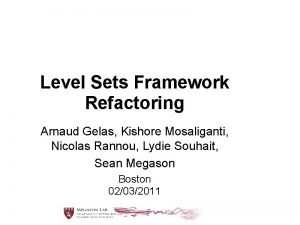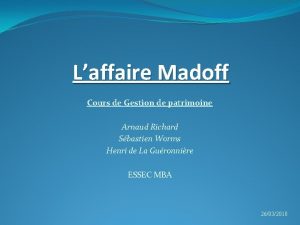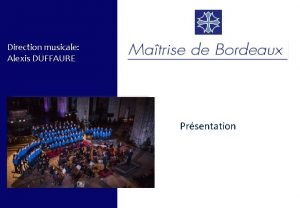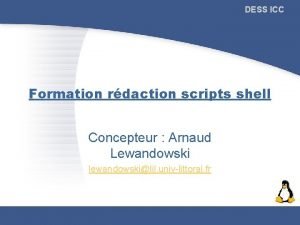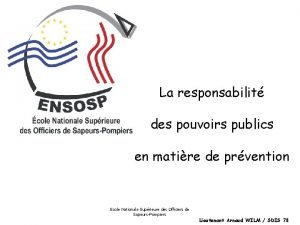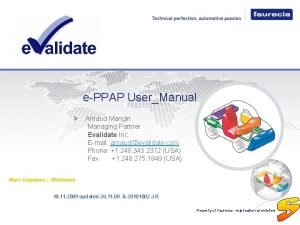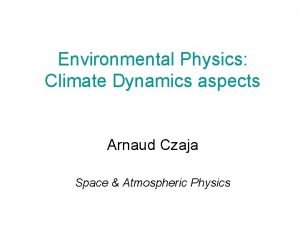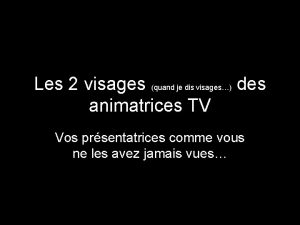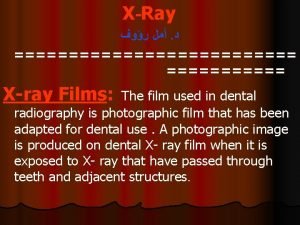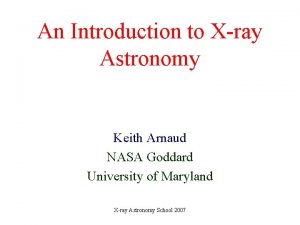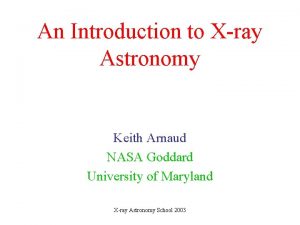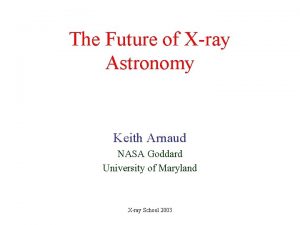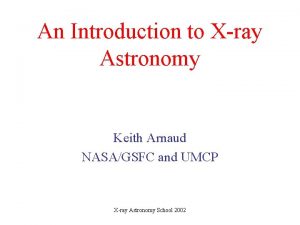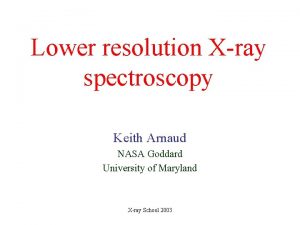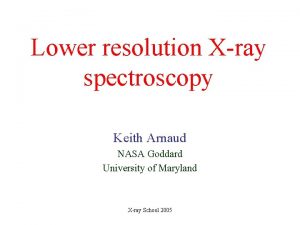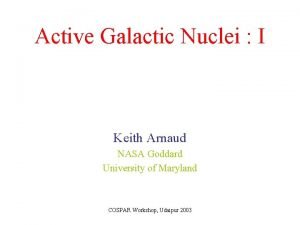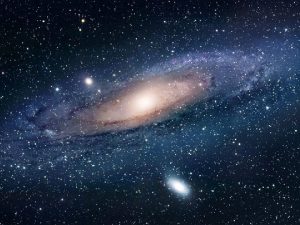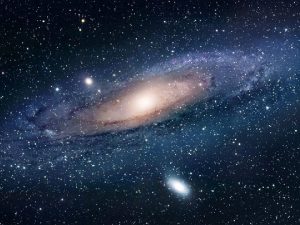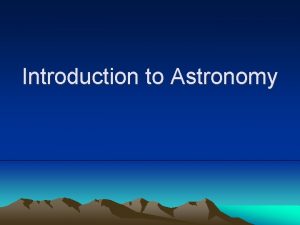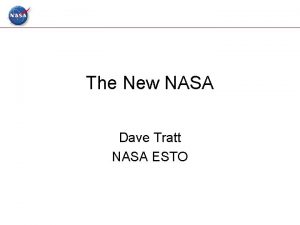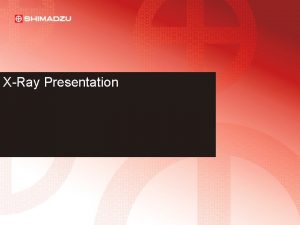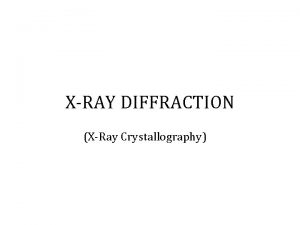An Introduction to Xray Astronomy Keith Arnaud NASA


































- Slides: 34

An Introduction to X-ray Astronomy Keith Arnaud NASA Goddard University of Maryland COSPAR Workshop, Udaipur 2003

• Preamble • A brief and idiosyncratic history • A few notes on X-ray data analysis COSPAR Workshop, Udaipur 2003

X-ray Astronomy Emission in the energy range 0. 1 - 100 ke. V (0. 12 -120 Angstroms). The atmosphere is opaque at these energies so all X-ray astronomy is done using satellites, rockets, and, at the highest energies only, balloons. So : • Our detectors have to work right the first time - we can’t go and fix them. Any problems have to be understood remotely and calibrated. • There are relatively few X-ray astronomy experiments so public data archives are very important. In this workshop we will concentrate on the 0. 1 -10 ke. V energy range covered by Chandra and XMM-Newton. COSPAR Workshop, Udaipur 2003

X-ray Processes X-rays are produced in hot and violent processes. Almost all pointlike X-ray sources are variable - some extremely variable. This has two important consequences : • Monitoring observations are more important in the X-ray band than any other. • There are few good calibration sources. The X-ray band includes the K-shell transitions (ie n=2 to 1) of all elements heavier than He. The continuum shape also provides important clues to the emission processes. COSPAR Workshop, Udaipur 2003

X-rays from the Sun The first astronomical X-ray experiments were performed in 1948 and 1949 using captured WWII V 2 rockets. X-rays were detected from the Solar corona by Herb Friedman and collaborators at the US Naval Research Lab (in Washington DC). It is still not fully understood how the corona is heated to X-ray emitting temperatures. COSPAR Workshop, Udaipur 2003

X-ray Binaries The breakthrough experiment was performed in 1962 by Bruno Rossi, Riccardo Giacconi, and collaborators at American Science and Engineering (AS&E) in Cambridge, MA. After two failures of the Aerobee rocket, they successfully launched a detector to look for X-ray emission from the moon. As the rocket spun the field-of-view passed over an unexpectedly bright X-ray source. This was designated Scorpius X-1. A followup campaign identified the X-ray source as a binary with a compact (neutron star) primary. Further rocket experiments in the 1960 s found other X-ray binaries as well as identifying X-ray emission from several SNR, from M 87, Cygnus-A and the Coma cluster of galaxies. COSPAR Workshop, Udaipur 2003

The First Extra-Solar X-ray Detection Giacconi et al. , 1962 Sco X-1 X-ray background COSPAR Workshop, Udaipur 2003

All-Sky Surveys The satellite experiments Uhuru (US) and Ariel-V (UK) performed the first all-sky surveys. These used collimated proportional counters with resolutions of degrees so the images of the sky were necessarily crude. However, these surveys detected many galactic binaries, SNR, clusters of galaxies, and active galactic nuclei. HEAO-1 (US) performed a more sensitive sky survey and made a precise measurement of the intensity and shape of the X-ray background (XRB). There was a long debate about whether the XRB was due to hot gas distributed through the universe or was the sum of many lower flux point sources. The latter is now known to be the case although it is still an interesting question whether the XRB can be completely explained by the sum of individual sources. COSPAR Workshop, Udaipur 2003

Uhuru (“Freedom”) Bruno Rossi Marjorie Townsend COSPAR Workshop, Udaipur 2003

Ariel V launch COSPAR Workshop, Udaipur 2003

Hot gas in the Perseus Cluster COSPAR Workshop, Udaipur 2003

COSPAR Workshop, Udaipur 2003

X-ray Telescopes X-ray focussing optics were used first to observe the Solar corona and then transferred to general astronomy with HEAO-2 (US), launched in 1978 and renamed the Einstein Observatory. The telescope imaged X-rays in the energy range 0. 5 -4. 0 ke. V. Many classes of astronomical objects were detected in X-rays. This was the first X-ray astronomy mission with a guest observer program and a “public archive” (which I used for my Ph. D thesis). Its successor, over a decade later, was ROSAT (Germany-US-UK), which performed an all-sky imaging survey in the 0. 2 -2. 5 ke. V range followed by longer pointed observations at specific targets. This generated a vast public database (which still has lots of potential) - and is a fertile source of targets for Chandra and XMMNewton. COSPAR Workshop, Udaipur 2003

Einstein Observatory COSPAR Workshop, Udaipur 2003

X-ray Detection of the Moon ROSAT PSPC COSPAR Workshop, Udaipur 2003

Large proportional counter arrays Parallel with the development of X-ray telescopes were missions designed to collect large numbers of X-rays from relatively bright sources to perform detailed spectroscopic and timing investigations. EXOSAT (ESA) was launched in 1983 into a deep orbit which allowed long continuous observations. It discovered Quasi Periodic Oscillations in X-ray binaries. Ginga (Japan-UK) was Japan’s third X-ray astronomy satellite and was launched in 1987. Important results were on Black Hole Transients and the detection of Fe lines and Compton reflection in active galactic nuclei. COSPAR Workshop, Udaipur 2003

EXOSAT lightcurve COSPAR Workshop, Udaipur 2003

Ginga COSPAR Workshop, Udaipur 2003

The current culmination of this line is the Rossi X-ray Timing Explorer (RXTE), launched at the end of 1995 and still operating, which has detected k. Hz oscillations in Galactic binary sources providing possible tests of GR effects in the vicinity of neutron stars and black holes. RXTE also carries an all-sky monitor which has produced long-term lightcurves for the brighter sources. COSPAR Workshop, Udaipur 2003

COSPAR Workshop, Udaipur 2003

High-throughput telescopes ASCA (Japan-US), launched in 1993, used high-throughput but relatively coarse resolution telescopes that operated in the energy range 0. 5 -10 ke. V. The importance of these telescopes was less in the imaging and more in reducing the background - which usually scales with the volume of the detector in space experiments. ASCA detected broad (100, 000 km/s) Fe lines from close to the black hole in active galactic nuclei. Beppo. SAX (Italy-Netherlands), launched in 1996, covered a very wide bandpass (0. 1 -300 ke. V) using a range of instruments. Its most important result was the discovery of gamma-ray burst afterglows. COSPAR Workshop, Udaipur 2003

ASCA observations of Fe K lines in AGN COSPAR Workshop, Udaipur 2003

Beppo-SAX detection of GRB afterglow COSPAR Workshop, Udaipur 2003

Great Observatories This brings us up to the present and the two major X-ray astronomy facilities launched in 1999 - Chandra and XMMNewton. Chandra boasts the best (and most expensive) telescope ever built, giving a sub-arcsecond resolution. Imaging is provided by CCD and microchannel plate imagers. High resolution spectroscopy by two gratings that can be placed in the optical path behind the mirrors. While Chandra is a successor to ROSAT, XMM-Newton follows the path of ASCA in providing greater mirror area but at lower resolution. XMM-Newton has 3 mirrors, 2 of which have reflection gratings, providing simultaneous high resolution spectroscopy and imaging. There is also an optical monitor telescope. COSPAR Workshop, Udaipur 2003

Chandra view of the Galactic center Wang et al. COSPAR Workshop, Udaipur 2003

40 years of X-ray astronomy have provided a billion times improvement in sensitivity and a quarter of a million times improvement in resolution. COSPAR Workshop, Udaipur 2003

X-ray data X-ray detectors are photon-counting in contrast to those in most other wavebands which measure incoming flux. In consequence, basic X-ray data usually comprise lists of events and their attributes. X-ray datasets are usually photon-limited, particularly for newer missions such as Chandra and XMM-Newton. Images, spectra, and lightcurves created from the event lists may well have a few or even no photons in many bins. The data analysis techniques (and statistics) developed in other wavebands may not transfer to X-ray astronomy. COSPAR Workshop, Udaipur 2003

X-ray data II The basic data file usually comprises time-tagged events, each with a position (in detector and sky coordinates) and an energy (often called channel, PHA or PI for historical reasons). Thus each event can be thought of as occupying a position in a 4 -D space. The event may have other attributes of interest - eg for CCDs the pattern of pixels from which the charge for this event was accumulated. It is often possible to increase S/N by selecting on these secondary attributes. After filtering the events as required we project them onto 1 -D or 2 -D subspaces and bin them up to give images, energy spectra, or lightcurves (time series). COSPAR Workshop, Udaipur 2003

X-ray data III Each of these binned datasets requires its own calibration products. • Image analysis uses : • exposure maps - the mirror and detector sensitivity across the field-of-view (taking into account any changes in aspect ie pointing direction). • point spread function (PSF) - the probability that a photon of given energy and position is registered in a given image pixel. • Energy spectral analysis uses : • response matrices - the probability that a photon of given energy is registered in a given channel. COSPAR Workshop, Udaipur 2003

The 3 Most Important Things for X-ray Data Analysis are : 1. Calibration COSPAR Workshop, Udaipur 2003

The 3 Most Important Things for X-ray Data Analysis are : 1. Calibration 2. Calibration COSPAR Workshop, Udaipur 2003

The 3 Most Important Things for X-ray Data Analysis are : 1. Calibration 2. Calibration 3. Calibration (The rest is “just” software, organization, and analysis. ) COSPAR Workshop, Udaipur 2003

The Calibration is Never Good Enough There is always a systematic error term associated with your data analysis. If you have the misfortune to have very high S/N then this systematic term may dominate. You usually can’t add the systematics in quadrature to the statistical uncertainties because the systematic uncertainties are usually correlated. Don’t over interpret data without thinking very hard about the quality of the calibration ! COSPAR Workshop, Udaipur 2003

Thank You Any Questions ? COSPAR Workshop, Udaipur 2003
 Keith arnaud
Keith arnaud Keith arnaud
Keith arnaud Keith arnaud
Keith arnaud Learning astronomy by doing astronomy
Learning astronomy by doing astronomy Learning astronomy by doing astronomy
Learning astronomy by doing astronomy Learning astronomy by doing astronomy activity 1 answers
Learning astronomy by doing astronomy activity 1 answers Kahulugan ng ngayon kakahigin ngayon tutukain
Kahulugan ng ngayon kakahigin ngayon tutukain Nasa www.nasa.gov
Nasa www.nasa.gov Arnaud ancion cardiologue
Arnaud ancion cardiologue Arnaud alcabez
Arnaud alcabez Arnaud ventura
Arnaud ventura Arnaud pasquiers
Arnaud pasquiers Arnaud marsollier
Arnaud marsollier Arnaud venet
Arnaud venet Arnaud czaja
Arnaud czaja Kishore mosaliganti
Kishore mosaliganti Arnaud courgey
Arnaud courgey Arnaud giovaninetti causa de la muerte
Arnaud giovaninetti causa de la muerte Docteur arnaud richard
Docteur arnaud richard Arnaud poujardieu
Arnaud poujardieu Arnaud
Arnaud Ncc poplar
Ncc poplar Arnaud
Arnaud Quizlet
Quizlet Concaténe
Concaténe Drabdad
Drabdad Wild berry
Wild berry Arnaud czaja
Arnaud czaja Arnaud wilm
Arnaud wilm Eppap faurecia
Eppap faurecia Arnaud czaja
Arnaud czaja Clemence arnaud presentatrice
Clemence arnaud presentatrice Arnaud gelas
Arnaud gelas X ray mastoid towne's view cholesteatoma
X ray mastoid towne's view cholesteatoma The label side of the dental film packet
The label side of the dental film packet
